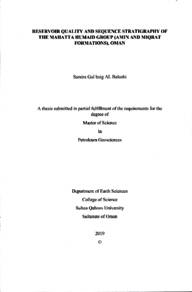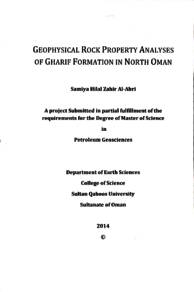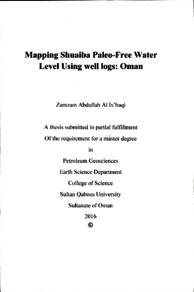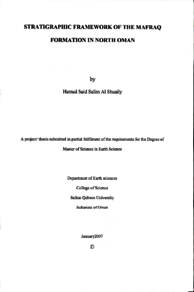Document
Diagenesis of the upper shuaiba reservoir in the Malaan Field, Northern Oman.
Publisher
Sultan Qaboos University
Gregorian
2008
Language
English
English abstract
The late Aptian Upper Shuaibe Formation in the Malan Field, Northern Oman requires understanding of the diagenetic history and its impact on reservoir quality to make po determine the paragenetic sequence, burial history and porosity evolution within a tectonostratigraphic framework
The Upper Shuaiba Formation in the Malaan area underwent different types of diagenetic alteration in the marine, nicar-surface (meteoric) and burial environments.
The marine diagenesis is represented by micritization of benthic forums, development of micrite envelopes and replacement of skeletal allochems and micrite by framboidal pyrite. Near-surface diagenesis was recorded from selective dissolution of aragonitic bioclasts and karstic features observed within the backshoal inner ramp rudist floatstone that is overlain by Nahr Umr unconformity. Non ferroan, isopacheous fibrous calcite, drusy, sparry calcite and syntaxial overgrowths calcite (on echinoids) cements are of possible meteoric origin. The presence of minor euhedral dolomite rbombs within bioclastic moulds and in the matrix that predate the burial cements may have possibly occurred in the mixing zone environment The burial environment consists of (a) sparty equant ferroan and non-ferroan calcite and dolomite cements occluding primary and secondary porosities, (b) saldle ferroan dolomite, (o)large crystals or nodules of pyrite due to shale compaction, (d) burial compaction features which are encountered from the compacted burrows (physical compaction) and from the sutured and non-sutured stylolites seams (chemical compaction) and (c) dissolution features that post-dated burial cements and stylolites.
It is interpreted from the burial history curve that during the Aptian/Albian the Upper Shuaiba reservoir underwent marine and near surface diagenesis phases During Late Cretaceous it was also influenced by major tectonic events which caused thrusting and uplift that croded all of the overlying Natih and Fiqa formations. This event was followed by regional subsidence and burial that caused most of the burial diagenesis features, interrupted only by minor uplift during the Oligocene when Oman Mountains were uplifted. During these tectonic episodes faults and fractures (conduits) were formed and were possibly responsible for two main events; (1) burial leaching by migration of the corrosive sulphur-rich oil from underlying reservoirs and (2) hydrocarbon charge that resided within the micro and macro-porosities formed during the meteoric and burial dissolution
The results of this work have enhanced our understanding of the processes controlling reservoir quality in the Upper Shuaiba reservoir. This in turn helps to reduce the uncertainties and improve the Malaan Field development. The good reservoir was encountered within the inner ramp to mid ramp facies that were effected by both meteoric and burial dissolution stages.
Member of
Resource URL
Same Subject



